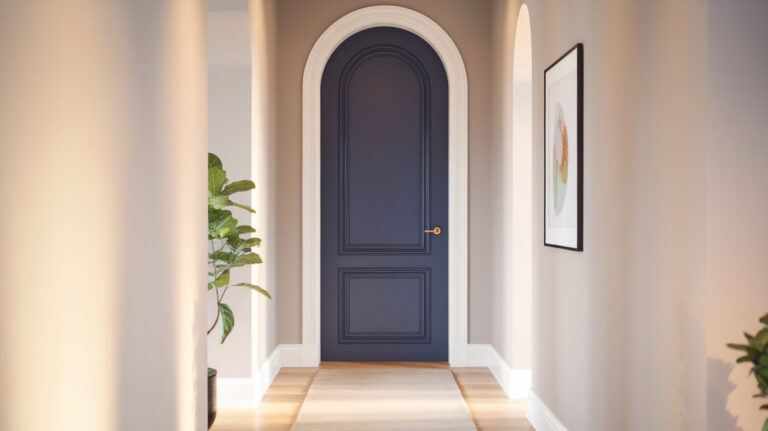In this blog, I’m diving into a game-changing design detail that often goes unnoticed-interior door paint ideas!
While walls and furniture steal the spotlight, doors are a hidden canvas waiting to be transformed. The right paint color or finish can turn a plain door into a stunning focal point, adding personality, contrast, or even a touch of elegance to your space.
Whether you want a classic, modern, or artistic touch, I’ve got you covered with creative and practical inspiration.
Why Paint Your Interior Doors?
First things first-why should you even bother painting your doors? Maybe you’re thinking, Doors are just doors. Does their color matter? The short answer: absolutely!
1. A Simple but Powerful Transformation
Painting a door is an easy way to refresh your space without a full-blown renovation. Whether you go for a subtle neutral or a bold statement shade, a new door color instantly elevates your home’s aesthetic.
2. Adds Character and Style
A painted door can give your home a designer feel. You might love the idea of moody black doors for a sophisticated look or pastel blue for a soft, airy feel. Whatever your style, the right door color helps define it.
3. Creates Contrast or Cohesion
Want to make your walls pop? A dark door against light-colored walls creates a dramatic contrast. A door painted in the same color as your walls blend beautifully. The choice is yours!
4. A Budget-Friendly Upgrade
Painting a door is one of the most affordable home improvement projects. A few supplies and some time are all you need to completely change the vibe of a room.
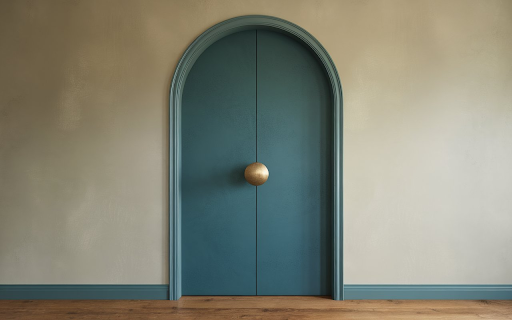
Best Colors for Interior Doors
Choosing the right color for your interior doors can completely transform the atmosphere of your home. Whether you want to make a bold statement or keep things subtle and sophisticated, the color you pick will influence how your space feels.
Classic Black
If you want to add instant elegance to your space, black is an excellent choice.
A black door creates a striking contrast against light-colored walls, making your space feel polished and modern.
It’s especially popular in homes with white or neutral-toned walls, as the contrast adds dimension and drama.
Black doors also have a timeless appeal, working well in both contemporary and traditional settings.
To prevent them from feeling too heavy, consider pairing them with gold or brass hardware for a sophisticated touch.
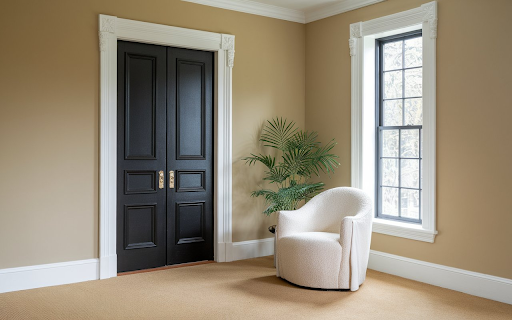
Soft Gray
Gray doors are a perfect middle ground between bold and neutral.
A light gray shade can create a soft, airy feel, making a space feel more open and inviting.
On the other hand, darker grays bring in a moody, luxurious vibe without the intensity of black.
Gray doors work well with almost any wall color, from crisp whites to earthy beiges and even muted pastels.
If you’re looking for a color that feels modern yet understated, gray is an excellent option.
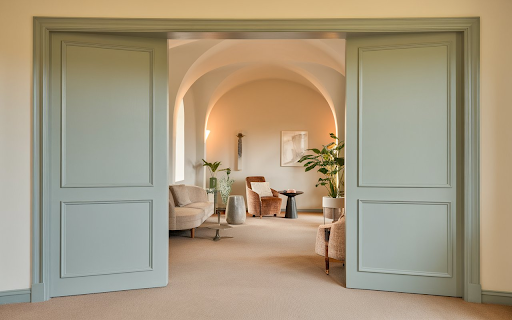
Navy Blue
Navy blue is a fantastic alternative to black if you’re looking for a deep, rich color that still feels refined.
This shade adds a touch of sophistication and works beautifully in classic, coastal, or even modern interiors.
Navy doors look especially stunning when paired with white trim, creating a crisp and polished look.
If you have light-colored walls, a navy door can serve as an eye-catching focal point without overwhelming the space.

White
White doors remain a popular choice for a reason-they’re clean and bright, and work with virtually any interior style.
If you want a seamless, classic look that never goes out of style, white is a foolproof option.
It makes spaces feel larger and blends effortlessly with surrounding walls, creating a cohesive feel.
However, if you’re worried about fingerprints or scuff marks, opting for a durable semi-gloss or satin finish will make maintenance much easier.

Warm Beige or Taupe
If you love neutral tones but want something softer than white, beige or taupe doors are a fantastic option.
These warm hues add coziness to a space while still feeling fresh and elegant.
They work beautifully in farmhouse-style homes, traditional interiors, or even minimalist spaces that lean toward earthy tones.
Beige and taupe doors also complement a wide range of wall colors, making them a versatile choice if you like to switch up your decor frequently.
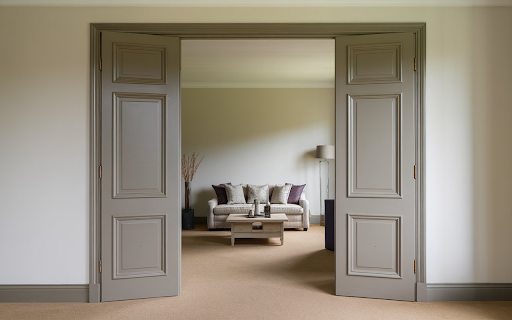
Sage Green
Sage green has been gaining popularity in interior design, and it’s easy to see why.
This muted, earthy green creates a sense of tranquility and brings a touch of nature indoors.
It pairs well with both warm and cool tones, making it a great choice for various interior styles.
Sage green doors can add subtle color without feeling overwhelming, making them perfect for creating a soft and inviting atmosphere in your home.
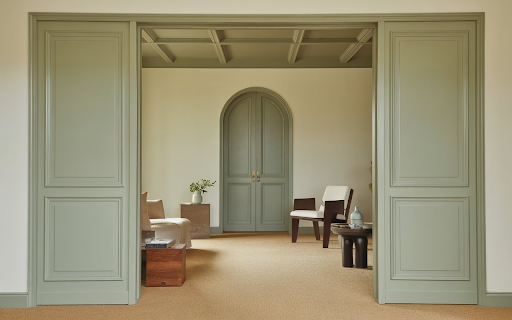
Deep Teal
For those who want to add color but still keep things sophisticated, deep teal is a fantastic option.
This rich, jewel-toned hue brings a luxurious feel to interiors while maintaining a sense of warmth and depth.
It works particularly well in eclectic, bohemian, or vintage-inspired spaces.
If you love bold colors but don’t want something too overpowering, teal offers the perfect balance of vibrancy and elegance.

Muted Pastels
Pastel doors, such as soft blush pink, powder blue, or pale lavender, can bring a touch of whimsy and charm to a space.
These colors work beautifully in bedrooms, nurseries, or homes with a cottage-style aesthetic.
While pastels are often associated with a lighthearted, playful look, when paired with the right decor, they can also create a very elegant and serene ambiance.
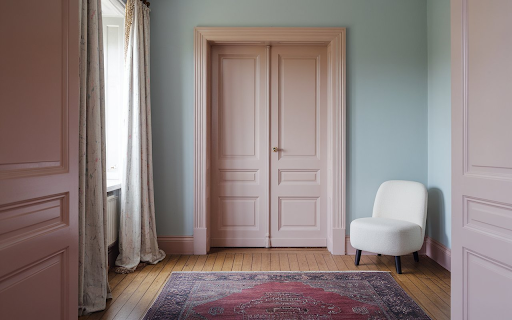
Dark Brown or Espresso
If you prefer a classic, timeless look, dark brown or espresso-colored doors are an excellent option.
These deep, rich hues add warmth and create a sense of coziness, making them perfect for traditional or rustic-style homes.
Dark brown doors work well with warm wall tones like beige, cream, or even deep reds and oranges, adding to their inviting appeal.

Two-Tone or Contrasting Doors
For those who love a creative touch, painting doors in two different shades can make a stunning impact.
You might choose to paint the front of the door one color and the back another, or highlight the edges with a contrasting shade for a subtle yet unique detail.
This technique works well in modern and eclectic interiors, adding an artistic and personalized feel to your space.
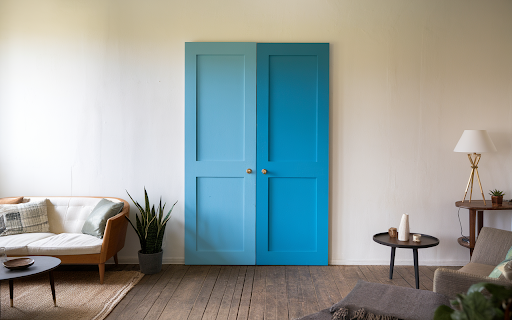
How to Choose the Right Paint for Interior Doors
Now that you’ve got some color inspiration, let’s talk about the practical side-what type of paint should you use?
1. Finish Matters
Flat or matte finishes look great on walls, but for doors, you need something more durable. Semi-gloss or satin finishes are your best bet-they resist fingerprints and are easy to clean.
2. High-Quality Paint Makes a Difference
You might be tempted to grab the cheapest paint, but trust me, investing in a good-quality one will make all the difference. Brands like Sherwin-Williams, Benjamin Moore, and Behr offer paints that give smooth coverage and last longer.
3. Consider Your Door Material
- Wood doors: Use a high-quality latex or oil-based paint.
- Metal doors: A paint with built-in rust protection is ideal.
- Previously painted doors: Always sand and prime first for the best results.
Step-by-Step Guide to Painting Your Interior Doors
Feeling ready to start your project? Here’s exactly how to do it!
Step 1: Prep Your Door
- Remove the door if possible (this makes painting easier).
- Clean it thoroughly to remove dust and grease.
- Sand it lightly for better paint adhesion.
Step 2: Apply Primer
- If your door is dark and you’re going for a light color, primer is a must.
- A good primer helps the paint stick and gives you a smoother finish.
Step 3: Start Painting
- Use a brush for the edges and a roller for the flat areas.
- Apply 2-3 thin coats for the best coverage.
- Let each coat dry completely before adding the next one.
Step 4: Let It Dry & Reattach
- Once your final coat is fully dry, reattach your door and admire your work!
How Much Does It Cost to Paint Interior Doors?
If you’re wondering about costs, here’s a rough estimate:
- DIY project: $20-$50 per door (just the cost of paint and supplies).
- Professional painting: $75-$150 per door (including labor).
If you’re painting multiple doors, hiring a professional can save you time and effort, but if you love DIY projects, this one is doable on your own!
Conclusion
Absolutely! A freshly painted door can completely transform your space with minimal effort and cost. Whether you want a subtle update or a bold statement, there’s a perfect door color for you. So go ahead-pick up that paintbrush and start your mini home makeover!
If you try this, I’d love to hear about it. What color are you thinking of using? Let me know in the comments! Happy painting!
FAQs
Should interior doors match the trim or wall color?
Not necessarily! While matching doors and trim create a seamless look, contrasting colors can add depth and character. A white trim with a bold-colored door, for example, makes a striking statement.
What’s the best paint finish for interior doors?
A semi-gloss or satin finish is ideal for interior doors. These finishes are durable, easy to clean, and resist scuff marks better than flat or matte paints.
Can dark-colored doors make a room look smaller?
Dark doors can add drama and sophistication, but in a small space, they might feel heavy. Pairing them with light walls and trim can maintain balance and prevent a cramped look.
How do I choose a door color that complements my home’s style?
Consider your existing color palette and overall vibe. Classic homes look great with black, white, or wood tones, while modern spaces can handle bold hues like navy or deep green.
Is it okay to paint each interior door a different color?
Absolutely! Mixing door colors can add personality to your home, especially if each room has its design theme. Just keep a cohesive color flow to avoid a disjointed look.

